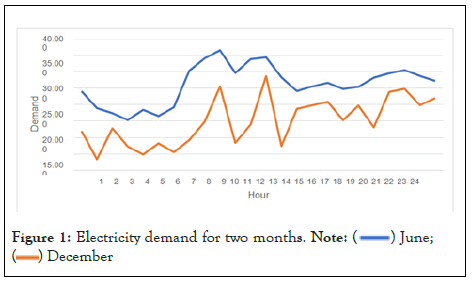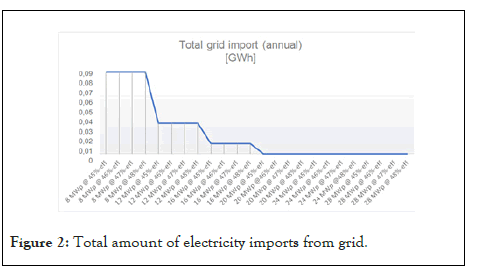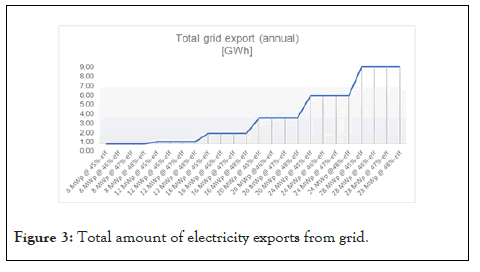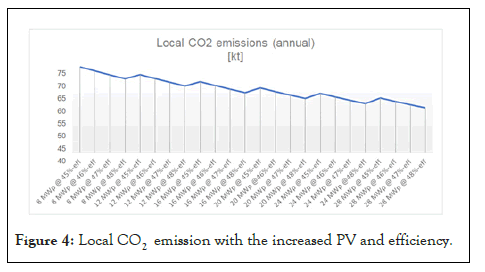
Journal of Fundamentals of Renewable Energy and Applications
Open Access
ISSN: 2090-4541

ISSN: 2090-4541
Research Article - (2022)Volume 12, Issue 3
Fossil fuels are the main primary resources for electricity generation in Pakistan. Over the last few years there has been a consistent growth in industrialization and population in the main cities, which might lead to such resources not being enough to fulfill the future energy demands in a sustainable way. Meanwhile, over half the remote rural areas are unable to access electricity. Consequently, it is necessary to look for the alternate solutions. This paper aims at studying technological solutions to meet such growing electricity demand, by also considering its environmental impact. For this purpose, a case study of a district in Pakistan is considered in its electricity demand; measured with an hourly resolution for a whole year that includes two different users: a set of factories and a residential district. The power plant uses two different electricity generation systems: a 22 MW combined cycle power plant and a 10 MW natural gas engine power plant, while also having access to the main national grid in case of need. The total demand of the industry included in the district is of 18MWh per year on average and the remaining production is supplied to the residential area. The industrial area consists of 12 factories and three commercial subsidiaries. In order to model the case study the Energy Plan software is used.
The study analyses a set of scenarios by considering: an increased capacity of a PV system versus increased efficiency of a fossil fired power plant. Results indicate that both solutions affect the emissions by a different magnitude, thus the best choice really depends on other technological and economical evaluations and assumptions.
Energy plan; District planning; Renewable energy systems; Low carbon districts
Energy is considered a vital aspect for any economy. Realizing the importance of energy, its demand is increasing more than 9% each year in Pakistan. Expectation is that the Energy demand will increase 8-fold by 2030 and 20-fold by 2050 [1]. Like most countries, Pakistan relies on fossil fuels to meet its energy necessities. As huge dependency on fossil fuels affects the national economy as well as leading to different environmental issues like CO2 emissions etc. Due to the rapid exhaustion of fossil fuels and other adverse effects of non-renewable resources planners and policy makers are introducing other eco-friendly alternatives [2]. In the past, policy makers in Pakistan made some policy blunders by making natural gas a main source of primary energy. Masood,A. discussed that these resources are allocated to different critical sectors of economy (households, commercial industry, power, and transport) as it never had a natural gas surplus. Moreover, pricing, exploitation and shortage of natural gas was not considered as a main factor. It was severely underpriced, over allocated, and excessively misused [3]. Now the Government is actively working to satisfy the increasing energy demand by studying the deployment an inter-state pipeline to import liquefied natural gas and liquid petroleum gas. Ahmad et al. show that the economic growth is the key predictor of energy demand in Pakistan. They investigated that soon energy prices will increase and this would affect the economy of the country significantly. Due to this constraint policy makers in Pakistan should aim to reduce dependency on imported fuels, which could be done by switching towards indigenous energy sources and by speeding up the development of proven local reserves e.g. coal and hydropower resources [4].
Geographically, Pakistan receives a massive amount of sun light throughout the year as it lies in the solar belt and the solar energy intensity in such area is approximately 1800-2200KWh/m2 per year. Given the current energy issue, it is important to exploit the solar energy resources [5].
A solar energy assessment of Pakistan by the World Bank reported that most areas are very rich in solar energy, especially in its largest and most populated province. Additionally, they stated that northern parts have a peak Direct Normal Irradiance (DNI) value of 2700 kWh/m2 , which is very desirable for solar energy generation [6]. Presently, Pakistan is facing the worst ever shortage of oil and gas reserves and people are bearing electricity outages in summer and natural gas shortages in winters. Perwez et al. worked on Pakistan’s sizeable energy reserves, and this study focused on the balance and match of supply-demand in the future electricity system based on different supply policy selections and demand assumptions [7]. To raise the economic growth of a country it is necessary to provide an adequate electricity supply and increase the generation capacity. As Pakistan has a larger solar potential. Through solar thermal and PV system, Pakistan can generate 2.345 million MWh of electricity per year with no CO2 emissions.
In this study a model for a large mixed (residential and industrial) district in Pakistan in built with the Energy Plan model: this is a comprehensive tool to model future energy scenarios and it is based on a bottom-up approach which can compute case studies in a very short time [8]. The bottom up approach deals with the engineering aspects of different technologies from conventional fossil fired to renewables. As for example Mathiesen et al. presented regional studies of Danish city (Copenhagen). The studies investigated renewable supply system using Energy Plan, with an hourly temporal resolution. The aim of this work was to support the long-term planning and development efforts of a 100% renewable energy system [9]. They also highlight the operational aspects of a Renewable Energy System (RES) [10].
This paper intends to present a case study that involves an industrial district in Pakistan. For this purpose, data depicting the electricity demand of such district was collected for every month for a time span of one year. The data was analysed by means of the Energy Plan model.
This framework is used to analyze different technological solutions to meet such demand assessing the environmental impact as CO2 emissions.
In this study results are shown by confronting two different decarbonisation strategies; increasing the capacity of a PV system and increasing the electric efficiency of the local power plant. Different PV capacities and efficiencies of the power plant were tested with the objective to study the electricity production, to reduction in CO2 emissions and the dependency on the national grid. Potential surplus of electricity are sold to the national grid,thus, in future scenarios also the use of storage systems could be studied.
Most of electricity in Pakistan is produced from fossil fired power plants by using resources like oil, gas and coal. The district that is considered for this study includes the largest defense industrial complex under the Ministry of Defense Production. Presently, it comprises of 12 factories and three commercial subsidiaries. Two natural gas fired power plants are installed for electricity production for a total generation capacity of 32MW. They are also providing electricity to a nearby residential area and consuming to the other parts of the industry. Power plant 1; consist of 5 gas boilers which are connected to two steam turbines for a total of 22MW overall electricity production from. In power plant 2; a total of 5 gas engines are installed. Each gas engine can produce 2MW of electricity. So, total generation from this power plant is 10MW. There is already an installed capacity of a photovoltaic system of 8MWp. A summary for all of the systems shown in Table 1. The district also has a connection to a national grid system. If a power plant shuts down or the demand is too high during the peak hours, then the national grid can be used as a backup (Table 1 and Figure 1).
| Supply System | Nominal capacity |
|---|---|
| Power Plant 1 | 22 MW |
| Power Plant 2 | 10MW |
| Power plant Total | 32MW |
| National Grid (If required) | 12MW |
| PV System | 8MWp |
| Demand | |
| Industry consumption during peak hours | 18MW |
| Residential Demand during peak hours | 14MW |
| Yearly total demand | 174.20 GWh |
Table 1: Supply and demand of industry.

Figure 1: Electricity demand for two months. Note:

Energy plan formulation
Firstly, the reference case is being built and validated using Energy Plan based on energy demand data from year 2018. The proposed test case includes an electricity demand that can be met by a power plant and a PV system. The input parameters are the installed capacities of each system and the hourly distribution of the electricity demand (for a whole year). In the base case the fossil fired power plant considered to have a 45% electric efficiency. Hence, the aim is to understand how to meet the user demand in cleanest possible way such by confronting a larger PV system and also to improving the electric efficiency. Currently, the local production of electricity is provided by the natural gas. The core concern of any electricity system is to balance the supply, demand and the efficiency but as for higher flexibility, typically requires higher consumption of fuel.
The main scope of study is to consider an increase size of PV and an increase of efficiency of the fossil fired power plant in the district. This is done by simulating a set of scenarios in Energy Plan with discrete increments in the two parameters in order to understand their effects in renewable integration potential and CO2 emissions.
Increased PV capacity with increased efficiency of a local thermal power plant
The set of scenarios is obtained by increasing the PV system capacity from the original 8 MWp to 28 MWp with 4 MWp increments, while the representative efficiency of the power plant is increased from the original 45% to 48% with 1% increases.
Figure 2 shows the trend of electricity that is imported from the national grid to the district grid at the time of need. As the capacity of PV increases and with the increased efficiency from 45% to 48%, it will significantly reduce the total the import of electricity from the national grid, thus the district becomes more independent from the grid. It will produce more amount of electricity from the PV system then the thermal power plant to meet the users demand. Eventually, it will rely less on the natural gas with the increasing capacity and thermal efficiency of PV and power plant respectively.

Figure 2: Total amount of electricity imports from grid.
Figure 2 shows the total electricity imported from the national grid during the whole year. It can be seen that the efficiency does not affect such amount, as it comes mostly from peaks in demand which the power plant cannot meet due to its maximum nominal power. But a PV system can actually avoid the need for such withdrawal already with a 20 MWp total capacity (more than doubling the original), making the district virtually independent from the main grid and thus increasing its resiliency.
The increased PV capacity entails the presence of a huge electricity surplus as in Figure 3. This shows the total electricity export from the district. Starting from the reference scenario where there is no surplus at all, as the PV capacity increases it will generate surplus amount of electricity. In the start, 8MWp to 28MWp exports go from 0 GWh to 8GWh per year. This over production has to be dealt with, and it could be achieved by installing an electric storage system or being fed to the national electricity grid system.

Figure 3: Total amount of electricity exports from grid.
Finally, the CO2 emissions generated in the district are analyzed in Figure 4, which shows the CO2 emissions throughout the scenarios. Higher shares of renewable energy and lower shares of thermal power can both lead to a CO2 emissions reduction.

Figure 4: Local CO2 emission with the increased PV and efficiency.
As shown in figure, CO2 emission at 8MWp capacity with efficiency 45% to 48 % reduces from 72kt to 68kt respectively. Overall 7% reduction occurs with the increased efficiency. As well as from 8MWp @45% to 12MWp @45%, CO2 emission reduces from 72kt to 69kt. Hence, it can be concluded that with the increased capacity of PV and increased power plant efficiency will decarbonize the grid and become more environment friendly (Figures 2-4).
It can be also computed that an increase in electric efficiency of 1% returns a reduction in carbon footprint of 1.38 kt on average, while an increase in 4 MWp of PV (with the respect to the original capacity) size is in the order of 2.8 kt (0.7 kt per MWp). But the reduction in emissions caused by installing more PV capacity decreases as the size of the system increases (getting to around 1.7 kt for the 28 MWp scenario), due to the fact that the electricity that can be used locally decreases progressively and has to be exported elsewhere, as shown in Figure 3.
A district in Pakistan is considered as a case study and represented by a one-year electricity demand, to be met by means of different electricity production system simulated with the Energy Plan software. An increased PV capacity with increased efficiency of a fossil fired power plant scenario is considered as low carbon options for the district. This study suggests that both a high capacity of photovoltaic system, it will increase the generation from PV and will reduce the dependency on main grid. to overcome the shortfall and generation of electricity can occur with PV. Research concluded that
• With the increase capacity of PV capacity and efficiency of the fossil fired power plant, local CO2 emissions can be greatly reduced.
• The district will become more dependent on solar resources and independent from the main grid and become less reliant on imported fuel.
• It will also help to decarbonize the national system by feeding electricity produced by renewables in it.
•Local emission could be furtherly incremented by means of a storage system to deal with the renewables surplus.
Citation: Nadeem A, Bartolini A, Kalvin R, Comodi G (2022) Low Carbon Options for Industrial Districts in Pakistan. J Fundam Renewable Energy Appl. 12:292.
Received: 18-Dec-2020, Manuscript No. JFRA-22-002-PreQc-22; Editor assigned: 21-Dec-2020, Pre QC No. JFRA-22-002-PreQc-22 (PQ); Reviewed: 04-Jan-2021, QC No. JFRA-22-002-PreQc-22; Revised: 01-Sep-2022, Manuscript No. JFRA-22-002-PreQc-22(R); Published: 08-Sep-2022 , DOI: 10.35248/2090-4541.22.12.295
Copyright: © 2022 Nadeem A, et al. This is an open-access article distributed under the terms of the Creative Commons Attribution License, which permits unrestricted use, distribution, and reproduction in any medium, provided the original author and source are credited.